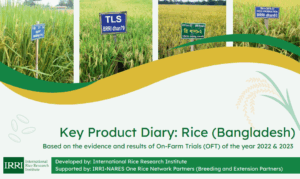by Kofi Britwum and Matty Demont
A key contribution of this study is the evaluation of consumer rice preferences—segments whose preferences in the context of cultural heritage and colonial heritage remain uncertain—and specifically, whether they are aligned with colonial heritage preferences. Such evidence on market segmentation could support policymakers and value chain actors in their efforts to spill over rice value chain upgrading between theSenegalese and Mauritanian river banks along the Senegal River Valley and a diverse group of other ethnicities from parts of West Africa.
Driven by colonial-era policies, demographic transitions, and urban bias tendencies, demand for imported Asian rice has been nearly ubiquitous over several regions in sub–Saharan Africa (SSA). In the Senegambia region, for example, this has been pinned to the intensification of peanuts as an exportable cash crop by colonial governments, necessitating imports of cheap rice from Indochina to mitigate the resulting food security threats.
These import substitution policies profoundly contributed to the popularity of imported broken rice, which in the ensuing years has evolved into a food identity marker defining local dishes in some of these regions. Consequently, currently a large consumer segment—in particular urban consumers in Senegal, The Gambia, and Mauritania—prefer rice with 100% broken grains.
Although rice imports across a large swath south of the African Sahara have continued to grow in the post-colonial era with further projected upward trends—the United States Department of Agriculture projects SSA to be the leading destination for imported rice by 2026, surpassing China—the global food crisis of 2007–2008 and the accompanying price hikes in food staples prompted many governments to explore rice import substitution by revamping fledgling local rice sectors.
Moreover, between 2018 and 2020, 44% of Africa’s wheat imports came from the Russian Federation and Ukraine. The 2022 war in Ukraine will further redirect African countries’ attention to local rice as a substitute for the massive expected shortfall in wheat imports. Therefore, programs such as the National Rice Development Strategies under the Coalition for African Rice Development will regain relevance in their efforts towards accomplishing local rice self-sufficiency and productivity.
Research that examined SSA consumers’ preferences for local rice suggested promising market potential and a willingness to pay (WTP) price premiums for improved quality of local rice through upgraded processing technologies, such as enhanced milling and sorting, improved parboiling, and the acceptance of newly bred local varieties.
Beyond these findings which altogether suggest potential growth in demand for local rice with improved product quality standards tailored to import-biased urban markets, insights from recent studies have revealed that geographical antecedents and ethnic affiliation may play a more crucial role in rice preferences in some SSA countries than has previously been acknowledged and understood.
Colonial import policies had indeed diverted consumer preferences in the Senegambia region away from indigenous African rice towards imported Asian rice with traits such as fragrance and broken grains. These stand at odds with consumer segments that maintained preferences for local rice passed on through cultural heritage, i.e., preferences for unbroken grains, no fragrance, and the sensory quality characteristics of indigenous African rice.
Earlier studies on rice preferences in some West African regions had found evidence of colonial heritage, although this was prior to the “colonial heritage” designation. Specifically, rice consumption patterns among urban Senegalese to be heavily skewed in favor of imported and cheap broken rice.
Based on rice auction experiments, these studies determined consumers’ willingness to upgrade standard Senegal River Valley (SRV) rice to SRV rice with upgraded intrinsic and extrinsic quality (the latter branded through the geographic origin label Rival®), and branded, imported Thai rice. Standard SRV rice is locally produced by farmers along the SRV and processed by semi-industrial and industrial mills, typically resulting in mediocre milling quality (characterized by its low purity and heterogeneous mix of varieties, broken and unbroken kernels).
These designs where standard, inferior rice benchmarks were upgraded to either improved local rice or imported rice with superior quality could be viewed as one angle to exploring import substitution with respect to consumers’ preferences. Alternatively, transposing the benchmark rice in experimental auctions where the imported rice is designated the benchmark with improved local rice as the upgraded product, represents another angle to examining the potential for import substitution, although this has received very little attention in the literature.
Rice cultural heritage in SSA originates from the domestication of the African rice species, Oryza glaberrima, and is believed to have been passed on through ethnic lineages. Geographically, the early domestication of the species was traced to the Inland Delta of present-day Mali approximately 2,000 to 3,000 years ago. From there, the species was believed to have spread to two main secondary centers of rice domestication: the coast of Gambia, Casamance, and Guinea Bissau, on the one hand, and the Guinean forest on the other.
O. glaberrima has been traced to two main ethnic groups, i.e., the Mande and Jola peoples (Diola in French). The Mande who are generally associated with rice-based cropping were originally in the upper Niger Basin during the thriving years of the Mali Empire, while the Jola people lived in the coastal swamps of the Casamance in present-day Senegal.
Given this background, the cultural heritage hypothesis postulates that consumers with genealogical or geographical proximity to early rice domesticators of the African rice species tend to prefer rice traits such as: (i) unbroken grains, (ii) no fragrance, (iii) sensory quality, and (iv) O. glaberrima parentage, preferences inherited from early rice domesticators.
Consumers in the Senegambia region with ethnicities unrelated to the original domesticators of African rice tend to predominantly feature preferences induced by colonial heritage, i.e., preferences for imported Asian rice traits, predominantly broken grains and fragrance.
In recent studies on local rice preferences among SSA consumers, several ethnicities traced back to early rice domesticators, i.e., the Mande people. These included the Mandinka, Karoninka, Serahule, Manjago, Fula (Pulaar in French), and Temne, tribes indigenous to Mali, Senegal, Guinea, and Guinea Bissau. Given their ethnic composition, cultural heritage in rice is, however, not as entrenched in Mauritania as it is elsewhere in Senegal or The Gambia.
Ethnically, Mauritania’s population is mainly composed of White Moors, Black Moors, mostly located in Mali, is splintered across other jurisdictions such as Mauritania. They are believed to have originated from the Mandinka people, an offshoot of the Mande. Ethnographic accounts also suggest the Soninke tribe was subsumed into Bambara, an indication of strong cultural alliances between the Bambara and the Soninke.
The majority of West African ethnicities are thus largely “immigrants” who settled in Mauritania from neighboring countries. Piecing these together, consumers who identify their ethnicities as Soninke or Bambara can be expected to have inherited rice preferences from the early domesticators. The Wolof and Fula tribes, on the contrary, likely lack this cultural heritage and feature preferences induced by colonial heritage.
With these ethnic affiliations, and with the goal of deepening our understanding regarding the influence of cultural and colonial heritage, we integrate these concepts using a dataset from a previous study in Mauritania, which was published prior to the hypothesis and subsequent validation of cultural and colonial heritage-induced rice preferences.
Additionally, the shared SRV between northern Senegal and southern Mauritania allows testing consumer response to spillovers of quality upgrading in rice value chains from Senegal into Mauritania.
A key contribution of this study is the evaluation of rice preferences for White Moors and Black Moors—segments whose preferences in the context of cultural heritage and colonial heritage remain uncertain—and specifically, whether they are aligned with colonial heritage preferences. Such evidence on market segmentation could support policymakers and value chain actors in their efforts to spill over rice value chain upgrading between the Senegalese and Mauritanian river banks along the SRV and a diverse group of other ethnicities from parts of West Africa.
The White Moors are of Arab-Berber origin, with historical evidence suggesting they were mostly livestock herders in the north of Mauritania; as such, they are considered to be far removed from rice cultural heritage. The Black Moors, on the other hand, are native to the Western Sahel region and of Maghreb descent, believed to have descended from slaves.
With a history of an ethnic class structure, Black Moors are considered a lower caste, and reportedly farmed grains along the SRV for the White Moor upper caste. Despite this history of grain farming, the Black Moor community does not share geographical or genealogical affiliations with original rice domesticators, and as such are not considered to be endowed with rice cultural heritage.
Peering further into the West African group in Mauritania are a variety of ethnicities from the sub-region, primarily the Soninke, Bambara, Wolof, and Fula. The Bambara tribe, while mostly located in Mali, is splintered across other jurisdictions such as Mauritania. They are believed to have originated from the Mandinka people, an offshoot of the Mande.
Ethnographic accounts also suggest the Soninke tribe was subsumed into Bambara, an indication of strong cultural alliances between the Bambara and the Soninke. The majority of West African ethnicities are thus largely “immigrants” who settled in Mauritania from neighboring countries.
Piecing these together, consumers who identify their ethnicities as Soninke or Bambara can be expected to have inherited rice preferences from the early domesticators. The Wolof and Fula tribes, on the contrary, likely lack this cultural heritage and feature preferences induced by colonial heritage.
With these ethnic affiliations, and with the goal of deepening our understanding regarding the influence of cultural and colonial heritage, we integrate these concepts using a dataset from a previous study in Mauritania, which was published prior to the hypothesis and subsequent validation of cultural and colonial heritage-induced rice preferences.
Despite this history of grain farming, the Black Moor community does not share geographical or genealogical
affiliations with original rice domesticators, and as such are not considered to be endowed with rice cultural heritage.
Peering further into the West African group in Mauritania are a variety of ethnicities from the sub-region, primarily the Soninke, Bambara, Wolof, and Fula. The Bambara tribe, while mostly located in Mali, is splintered across other jurisdictions such as Mauritania. They are believed to have originated from the Mandinka people, an offshoot of the Mande.
Ethnographic accounts also suggest the Soninke tribe was subsumed into Bambara, an indication of strong cultural alliances between the Bambara and the Soninke. The majority of West African ethnicities are thus largely “immigrants” who settled in Mauritania from neighboring countries.
Piecing these together, consumers who identify their ethnicities as Soninke or Bambara can be expected to have inherited rice preferences from the early domesticators. The Wolof and Fula tribes, on the contrary, likely lack this cultural heritage and feature preferences induced by colonial heritage.
With these ethnic affiliations, and with the goal of deepening our understanding regarding the influence of cultural and colonial heritage, we integrate these concepts using a dataset from a previous study in Mauritania, which was published prior to the hypothesis and subsequent validation of cultural and colonial heritage-induced rice preferences.
Additionally, the shared SRV between northern Senegal and southern Mauritania allows testing consumer response to spillovers of quality upgrading in rice value chains from Senegal into Mauritania.
A key contribution of this study is the evaluation of rice preferences for White Moors and Black Moors—segments whose preferences in the context of cultural heritage and colonial heritage remain uncertain—and specifically, whether they are aligned with colonial heritage preferences. Such evidence on market segmentation could support policymakers and value chain actors in their efforts to spill over rice value chain upgrading between the Senegalese and Mauritanian river banks along the SRV.
Suggestions to value chain actors to incorporate consumer preferences into upgrading strategies in Africa have been echoed in several studies as an avenue to increasing market shares of local rice products. Even with seemingly complex rice consumer segments as is the case for Mauritania, understanding these segments is key in any effort at improving the demand for local rice.
Although the improved Rival® rice garnered price premiums among Mauritanian consumers, the imported Thai version was hugely popular, and was in several instances perceived as more appealing than Rival® rice. These findings will be of interest to food policymakers, value chain actors, agribusiness entrepreneurs, and breeding programs working to expand local rice offerings in their efforts to spill over rice value chain upgrading across the
Senegalese and Mauritanian river banks of the SRV.
From a methodological perspective, our split experiment confirms findings from the literature that the choice of the benchmark matters and that the endow and upgrade method is reference-dependent. In particular, the fact that consumers discounted the alternative rice types when the benchmark was imported rice suggests the imported rice was perceived to be of a higher value than standard SRV rice, and this was consistent with field observations and market prices.
Since the two benchmarks were not perceived to be entirely comparable, it also meant that they did not completely mirror preferences for Rival® rice, marking this as a limitation of the endow and upgrade method. Together, these suggest that care should be taken in choosing the benchmark in an endow and upgrade framework, failing which actual preferences could be confounded.
Read the study:
Britwum K and Demont M. (2022) How does colonial heritage segment food markets? Evidence from rice consumers in Mauritania. Q Open.






